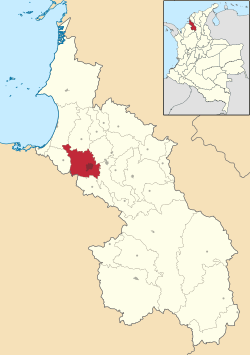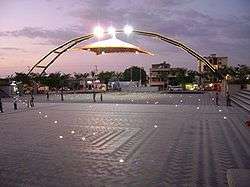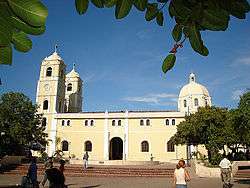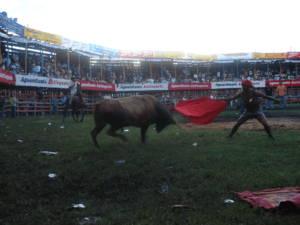Sincelejo
| Sincelejo | ||
|---|---|---|
| City | ||
| ||
| Nickname(s): La Perla de la Sabana / La Ciudad del Encuentro | ||
| Motto: "Más Soluciones, Más Compromiso" (More Solutions, More Commitment) | ||
 Location of the municipality and city of Sincelejo in the Department of Sucre | ||
 Sincelejo Location of the municipality and city of Sincelejo in the Department of Sucre | ||
| Coordinates: 9°17′42″N 75°23′46″W / 9.29500°N 75.39611°WCoordinates: 9°17′42″N 75°23′46″W / 9.29500°N 75.39611°W | ||
| Country |
| |
| Region | Caribbean Region | |
| Department | Sucre | |
| Established | October 4, 1535 | |
| Founded by | Antonio de la Torre y Miranda | |
| Government | ||
| • Type | Municipality | |
| • Mayor | Jacobo Quessep Espinosa | |
| Area | ||
| • City | 278.4 km2 (107.5 sq mi) | |
| • Urban | 18.9 km2 (7.3 sq mi) | |
| Highest elevation | 240 m (790 ft) | |
| Lowest elevation | 180 m (590 ft) | |
| Population (2016) | ||
| • City | 279,031 | |
| • Density | 1,000/km2 (2,600/sq mi) | |
| Demonym(s) | Sincelejano | |
| Time zone | EST (UTC-5) | |
| Area code(s) | 57 + 5 | |
| Website | Official website (Spanish) | |
Sincelejo (Spanish pronunciation: [sinseˈlexo]) is the capital and the largest city in the Colombian department of Sucre. It is also the main city in the denominated Región Sabanas (Savannas Region), a subdivision of the Caribbean Region of Colombia, and the 23rd biggest city by population in Colombia.[1] The city is located 30 kilometers from the Caribbean Sea by the Gulf of Morrosquillo; 125 kilometers from Cartagena and 200 kilometers from Barranquilla.
History
The land comprising the municipality of Sincelejo was inhabited in the prehispanic age by several groups of indigenous people, possibly speaking languages of the Chibchan language family, known as the Zenú. Sincelejo was founded on October 4, 1535, with the name of San Francisco de Asís de Sincelejo, the saint day of Francis of Assis. It was located on the site of a small Zenú indigenous settlement. The village used to be a part of Alonso Padilla's encomienda between 1610 and 1640. In those times the native indigenous people from that region were overpowered and exploited by the Spanish colonizers or encomenderos.
On November 21, 1775 Sincelejo was refounded by the Spanish captain and engineer, Antonio de la Torre y Miranda following the orders from Cartagena's governor Juan de Torrezar Díaz Pimienta. The building of the town started with a church and the lands around it was given to people who used to live spread all over the region in order to consolidate a religious and political center in the zone. Sincelejo was supposed to follow the classical Spanish colonial grid with the main church and its square in the center, but it was not possible because of the several creeks that break through the town.
It is still unknown where the name "Sincelejo" comes from, some historians claim the name to be indigenous, coming from an indigenous word Sinçel or Çincel, but another theory states that the name is Spanish and that Sincelejo was named after Francisco de Sincelejo, but there are not historical records that confirm the existence of a man with that name.
In 1812, Sincelejo became shelter for the revolutionary priests in La Rebelión de los Curas (Priests' Insurrection) held back the same year. In 1887 Sincelejo became one of the head towns in the Province of Cartagena. In 1908 it became the capital of the department of Sincelejo, which had a short-lived period, becoming part of the Province of Cartagena again in 1910. In 1912, Sincelejo almost disappears because of a huge conflagration, which took down the most of the central zone, nevertheless the town was rebuilt, having a particular architecture belonging to that age, mostly in the center zone of the town. In 1966 with the creation of the Sucre Department, Sincelejo became the capital of this department.
On January 20, 1980 the Corralejas stadium collapse occurred when an arena collapsed, killing at least 200 people.
Geography
The town of Sincelejo is typical of mountain scenery. It consists of irregularly-shaped surfaces and complex, with variable slope and altitudes ranging from 50 to 260 meters. Includes types of reliefs called hogbacks, bars and outcrops consist of materials of calcareous sandstones and limestones. The warm weather is dry, with average annual rainfall of 500–1200 mm, the vegetation according to Holdridge's tropical dry forest. Natural vegetation are some species such as palm wine, saman, oak, cortadera, squat and Macondo.
The hilly landscape in the town of Sincelejo is the most important by the extent that it occupies. It extends from the mountain scenery, to the borders of the plateau in the north and south. Likewise, in the rugged topography of rolling hills, moderately to strongly broken, with slopes between 7-50% and with mild to moderate erosion. This unit is located in the northwestern part of town to the townships of El Cerrito, El Beque, Las Majaguas, and Las Palmas The goatee, between 50 and 180 meters above sea level in dry warm weather, too, the soils are moderately deep, well drained soils developed from sandstone. This unit is dedicated to extensive livestock production with natural grasses, the highest residues remain outstanding, the natural vegetation has been destroyed the way they relate to the different areas corregimentales each other and with the town bears the same applies to Sincelejo radial morphology.
The intersection point occurs at the center of the city and the system is supplemented in rural areas with few roads that make up the rings that allow for intercommunication between the settlements that serve as headers and other minor corregimentales located along or at the end of the above radios. There is a strong relationship between Sincelejo and townships in the municipality of Corozal and Mamon, Don Alonso and swimming pool, as with the towns of Sampués, San Andrés de Sotavento, Palmetto and Toluviejo. The city of Sincelejo is a typical example of the settlement with indigenous origins and the crossroads.
In turn, the different villages that developed along the roads and the crossing point were integrated to the original Indian village to form a cluster of greater importance today called Sincelejo, the path outlined in the sense north - south joined the Villa de San Benito Abad to Tolu, and the east - west Chinú connected to Corozal and Sahagún.
The landscape of foothills at the foot of the small mountain foothills in the municipality, to the west, bordering the marine fluvial plain to the border with the town of Palmito. The terrain varies from flat to incline.
Boundaries of the City
- The south by the municipality of Sampués and Córdoba Department.
- To the west with the municipalities of Palmito and Tolú.
- To the north by the municipalities of Tolú and Toluviejo.
- To the east with the municipalities of Corozal and Morroa.
Climate
Sincelejo is in the tropics, so its temperatures does not change too much along the year, keeping an average temperature about 27-28 °C, the difference is made by the precipitation, which does change. It has a tropical wet and dry climate (Aw) according to the Köppen climate classification. The Drought season usually starts in the first or second half of December and it extends until the second half of February or the first half of March, then the Rainy Season starts sporadically at the beginning and gradually increasing until getting a peak in April or May, in June and July the amount of precipitation decrease a little (In a period of time called "Veranillo de San Juan") and eventually it increases again until it reaches the most rainy point in September, October or even in November.
| Climate data for Sincelejo | |||||||||||||
|---|---|---|---|---|---|---|---|---|---|---|---|---|---|
| Month | Jan | Feb | Mar | Apr | May | Jun | Jul | Aug | Sep | Oct | Nov | Dec | Year |
| Average high °C (°F) | 38 (100) |
38.4 (101.1) |
38 (100) |
38.6 (101.5) |
37 (99) |
36.2 (97.2) |
37.2 (99) |
36.4 (97.5) |
35.8 (96.4) |
35.6 (96.1) |
35.4 (95.7) |
36.0 (96.8) |
36.88 (98.36) |
| Average low °C (°F) | 18 (64) |
18 (64) |
19.4 (66.9) |
18 (64) |
18 (64) |
17.8 (64) |
18 (64) |
18.4 (65.1) |
18.2 (64.8) |
18 (64) |
19 (66) |
18.3 (64.9) |
18.26 (64.64) |
| Average precipitation mm (inches) | 15.9 (0.626) |
24.3 (0.957) |
36.3 (1.429) |
91.7 (3.61) |
141.7 (5.579) |
133.5 (5.256) |
133.4 (5.252) |
146.8 (5.78) |
142.6 (5.614) |
126.7 (4.988) |
88.1 (3.469) |
35.1 (1.382) |
1,116.1 (43.941) |
| Source: Ideam [2] | |||||||||||||
Administrative divisions
Sincelejo is subdivided into an urban zone and a rural zone. The urban zone is divided into 9 Comunas (Townships), while the rural has 21 divisions named Corregimientos.[3]
Urban Division[4]
| La Selva Villa Orieta |
San Carlos Kennedy |
Pioneros Argelia |
Majagual El Zumbado |
La Palma La Ford |
La Vega La Fé |
Margaritas Florencia |
Uribe Gran Colombia |
Verbel El Progreso |
Rural Division[4]
| San Rafael La Arena La Chivera Las Majaguas La Peñata |
Las Huertas Laguna Flor Cerrito de la Palma Cruz del Beque San Antonio |
Buenavista Buenavistica San Martín San Jacinto Cerro del Naranjo Babilonia Sabanas del Potreto La Gallera |
Las Palmas Castañeda Chochó |
Demographics
Sincelejo has an estimated population of 219,639 according to DANE 2005 Census. The 83.7% of the housing are houses, while 12.1% are apartments. The 98.1% of the housing have regular electricity; 83.7%, sewage system; 79.7%, regular water supply; 79%, natural gas and 50% telephones. In Sincelejo, the 51.7% of the residents are women, while the 48.3% are men. The literacy rate is 87.5%. The 14.5% of the citizens of Sincelejo recognize themselves as Indigenous people; 9.4% as African-Colombians and the rest, the 76.1% recognize themselves as mestizos(mixed-race).[5]
In 2009 Sincelejo has an estimated population of 234,886 according with DANE projections. According with DANE census there are sincelejanos in Australia, Argentina, Bolivia, Peru, Mexico, Canada, Ecuador, Panama, Costa Rica, Spain, USA, Venezuela, and others. The 69.5% of the city population is originally of Sincelejo, the 30.3% are Colombians from other cities of the country and the 0.2% are from other countries.
Economy
The main economic activities of the municipality of Sincelejo revolve around the area and neighboring department specifically in the livestock sector, agriculture and commerce and other services. For the excellent quality of their cattle high selection, Sincelejo has been called the "Capital Cebuísta de Colombia" has a wonderful breeding, fattening up and perfect conditions for animal consumption in the regional markets, the dairy in smaller scale, it is also important within the first of the city's economic lines.
In agriculture, livestock farming is compared with only a secondary economic power, highlighted the production of maize, cassava, yams and bananas. Although trade, that is quite active and other services, especially the government, are important in Sincelejo, only economically serve the municipality to supplement the primary activities of the agricultural sector.
The industry is just beginning to wake up in the city with its new factories, including Postobón stands, Almidón, clothing, footwear, Icopor, metal equipment, bricks, concrete, construction materials and wood processing in particular, highlights the great vocation microenterprise in the municipality that the future outlook becomes more promising of the municipality in the short and medium term.
In short, the economy is sustained Sincelejo trade and services offered by banks, chain stores, clinics, restaurants, service stations, fixed and mobile telecommunications, road and air transport, automobiles, workshops. According to a recent census of Industry and Commerce, are about 3000 establishments of all kinds of operating in the capital.
Culture
Traditional music of Sincelejo are porro and fandango (similar to samba to Brazilians). The typical dish of this city is mote de queso which is a soup with cheese. City is known for its 'hamacas' (hammocks) and sombrero vueltiao, which are both made by the native inhabitants. The sombrero vueltiao is also known as a national symbol for Colombia. The city is also the seat of the Roman Catholic Diocese of Sincelejo.
Every January Sincelejo opens the holiday for the Jesus's Sweet Name (Fiestas del dulce nombre de Jesús) which takes place on January 20, but the festival begins days early and it includes several parades, a beauty contest and several days of bullfighting within a temporary wooden circular structure similar to a stadium named Corraleja, that is why the holiday is also called Las Fiestas de Corraleja. On January 20, 1980, a combination of overcrowding and panic caused the bullring's wooden bleachers to collapse, killing 222 persons, although some estimates place the death toll at almost 400, this tragedy put on hiatus the traditional Corraleja despite the holiday took place every year, only in 1999 the municipality authorized the construction of the wooden structure renewing the bullfighting.
In Sincelejo also takes place the National Meeting of Bands (Encuentro Nacional de Bandas) which is a musical contest where folk bands perform the traditional musical styles in the Savanna Region: Porro and Fandango. This contest started in 1984 and it takes place in the mid-year and it awards creativity and performance.
Another cultural yearly event in Sincelejo is Festival Sabanero del Accordeón (Savanna's Accordion Festival). Unlike the National Meeting of Bands, this festival is about the folk musical styles but by the accordion and it includes four styles: Paseo, Merengue, Cumbia and Porro. The first winner of this contest was Lisandro Meza in 1974.[6] The festival was created to show the Savanna's culture to the country and to the world, that is why there are always some controversy when the styles of Valledupar, specially the paseo, get to win.
Sincelejo has got several institutions devoted to the cultural work like "La Escuela de Bellas Artes" (English: School of Fine Art), Batuta among others.
Sites of interest

Majagual Plaza: Usually called "La Placita de Majagual" (The Little Plaza of Majagual), this place was often referred in several folk songs from artist like Joe Arroyo. This plaza was the epicenter of the January 20 Corralejas for many years before this show was moved to "La Plaza de Mochila" where it took place the disaster of 1980. Since then Majagual Plaza was only useful for activities related with sports, but in 2007 it was relaunched under a new concept and post-modern design with an arch-shaped sculpture and a wide square for cultural events.
 Santander Park and Saint Francis of Assis Cathedral |
Santander Park and Saint Francis of Assis Cathedral: As old as Sincelejo, the Santander Park was opened in 1776 and it was the first place where the January 20 Corralejas took place in 1845 until 1964 where it was moved to Majagual Plaza. Just next to the park it is located the Saint Francis of Assis Cathedral (Catedral San Francisco de Asís), which was established in 1853 and it is the center of the religious parties that take place along the year in Sincelejo like Easter, Virgin Mary, Sacred Heart and the most important that takes place on January 20: The party of the sweet name of Jesus (Las Fiestas del Dulce Nombre de Jesús).[7]
Sincelejo's Municipality Theater: It was established in 1997 and it is a beautiful facility where concerts, musicals, folk events and theater operas take place. It is the cultural facility for excellence in Sincelejo.
VIVA Sincelejo Shopping Center: The VIVA Sincelejo Shopping Center (Centro Comercial VIVA Sincelejo) was opened in August 2006, as Saint Francisco Shopping Center (Centro Comercial San Francisco) and it had a pleasure ground for children, four movie theaters, and shops. It was located on Las Peñitas Avenue (Avenida Las Peñitas), the investment was about ten thousand million pesos.
In 2011 began the construction of a new mall in the same place, The VIVA Sincelejo Shopping Center, and it will have 91 shops where it is possible to find clothes, shoes, food and entertainment. The mall's area is about 31,000 square meters including parking space for 453 cars and 201 motorcycles. The very first stage of the mall was inaugurated in May 2013, the second one in August and the third one in November. The total investment for this facility is twenty-five thousand million pesos (About 12.5 Million US Dollars). This mall holds the biggest shopping center in Sincelejo: Almacenes Exito.[8]
Corraleja

Sincelejo is best known for its yearly folkloric and religious party: The 20th of January Party also known as Jesus' Sweet Name Party which takes place around January 20. This party includes a structure known as Corraleja, which is a temporary crafty wooden bullring, where the main attraction is watching the bullfighters facing the bulls, there is no economic retribution officially stated for the bullfighters that dare to face the animal, but usually the wealthiest landowners state an unofficial incentive (in money) for those who get to stab the bull using small prickers. The picadors are also a part of the show, but they belong to cattle raising farms and they're paid for their work, but the unofficial incentive also applies for them.
The construction of the temporary bullring starts at the end of December, and civil engineers and architects supervise the work of dozens of workers. The bullfighting takes places in four or five journeys (a journey a day), usually including the weekend. Different cattle rising farms (previously chosen) are in charge of supplying the bulls -about 40 bulls per day- so at the end of the last day the most entertaining journey is chosen -with an active people's participation- and the cattle rising farm is awarded with an official incentive. The ticket for watching a bullfighting journey costs about 15-35 US Dollars and usually the last journey is the more expensive.
The main criticism of the corraleja is the bad treating to the animals, not only in the bullfighting but its previous preparation; the security of the usually not skilled bullfighters, the consumption of alcohol within the bullring for watchers and bullfighters. Actually everybody who dares to join the bullfighters must have insurance, that are sold right there before getting inside the bullring, so if they are hurt or wounded, the medical costs are covered.
Media
Two local dailies circulate in Sincelejo: El Meridiano de Sucre and El Universal Sincelejo. Furthermore, regional and national newspapers also circulate like El Tiempo, El Espectador and El Heraldo.
There are several radio broadcasting stations: On A.M. there are Radio Caracolí, Radio Piragüa, Radio Chacury, Radio Sabanas, Radio Sincelejo, Ecos de la Sierra Flor and local stations of RCN Radio and Caracol Radio. On F.M. there are Olimpica Stereo, Tropicana Stereo, Primavera Stereo, Bésame, 94.3 F.M., Marina Stereo and Unisucre FM Stereo, Radio Tiempos.
Via radio waves, Sincelejo receives five national television channels: RCN, Caracol, Canal Uno, Señal Colombia and Señal Institucional. Moreover, there are two cable TV services: Claro and Cable Unión. Claro holds the only local TV channel named Canal Doce (Channel 12) exclusive for its subscribers and it includes several programs like magazines and a newscast devoted to Sincelejo and its zone of influence.
Transportation
Sincelejo is known for being an important crossroad on the Colombian Caribbean, it is placed close to several important towns on the region (Montería, Magangué, Coveñas and San Marcos) and also it is placed relatively close to important cities in Colombia like Barranquilla, Cartagena, Valledupar and Medellín. There is regular transportation from Sincelejo to these places by bus and taxi, with taxis being a little more expensive.
15 kilometers away from Sincelejo is Las Brujas Airport where is possible to find daily flights to the major cities in Colombia: Bogotá and Medellín.
Education
As the main city in Sucre and the Savannas Región, Sincelejo holds a big number of students, with 35 public schools and several private schools. Also, there are several universities: Universidad de Sucre, which is the only official public university in Sincelejo and Sucre. There are several private universities: CECAR, CORPOSUCRE, CUN, Universidad San Martín, Universidad Santo Tomás, EAFIT, Remington and there is a local office of Universidad de Pamplona. There are several institutions offering technical and technological short careers, being the most important the local office of SENA.
External links
References
- ↑ http://www.dane.gov.co Censo 2005 Dane
- ↑ "Principales parámetros meteorológicos, Sincelejo" (in Spanish). Ideam. August 2011. Retrieved 2008-06-25.
- ↑ Plan de Ordenamiento Territorial de Sincelejo 2004–2007
- 1 2 Sincelejo, Knol http://knol.google.com/k/carlos-mario-castro-navarro/sincelejo-colombia/1i29ptfum49sf/18#
- ↑ http://www.dane.gov.co Boletin Perfil Sincelejo
- ↑ Sabanero, http://members.fortunecity.es/sabanero/acerca.htm
- ↑ Cultura Colombiana Sinic
- ↑ http://www.exito.com/AmpliarPublicacion.aspx?id=572 Centro Comercial San Francisco
